Unconscionable Bargain: Principles and Legislation
VerifiedAdded on 2023/01/20
|13
|4141
|83
AI Summary
This article explores the concept of unconscionability in contract law and how it has been extended to legislation. It discusses the principles of unconscionable conduct and the requirements for a claim of unconscionable bargain. It also examines the Australian Consumer Law and its provisions on unconscionable conduct.
Contribute Materials
Your contribution can guide someone’s learning journey. Share your
documents today.
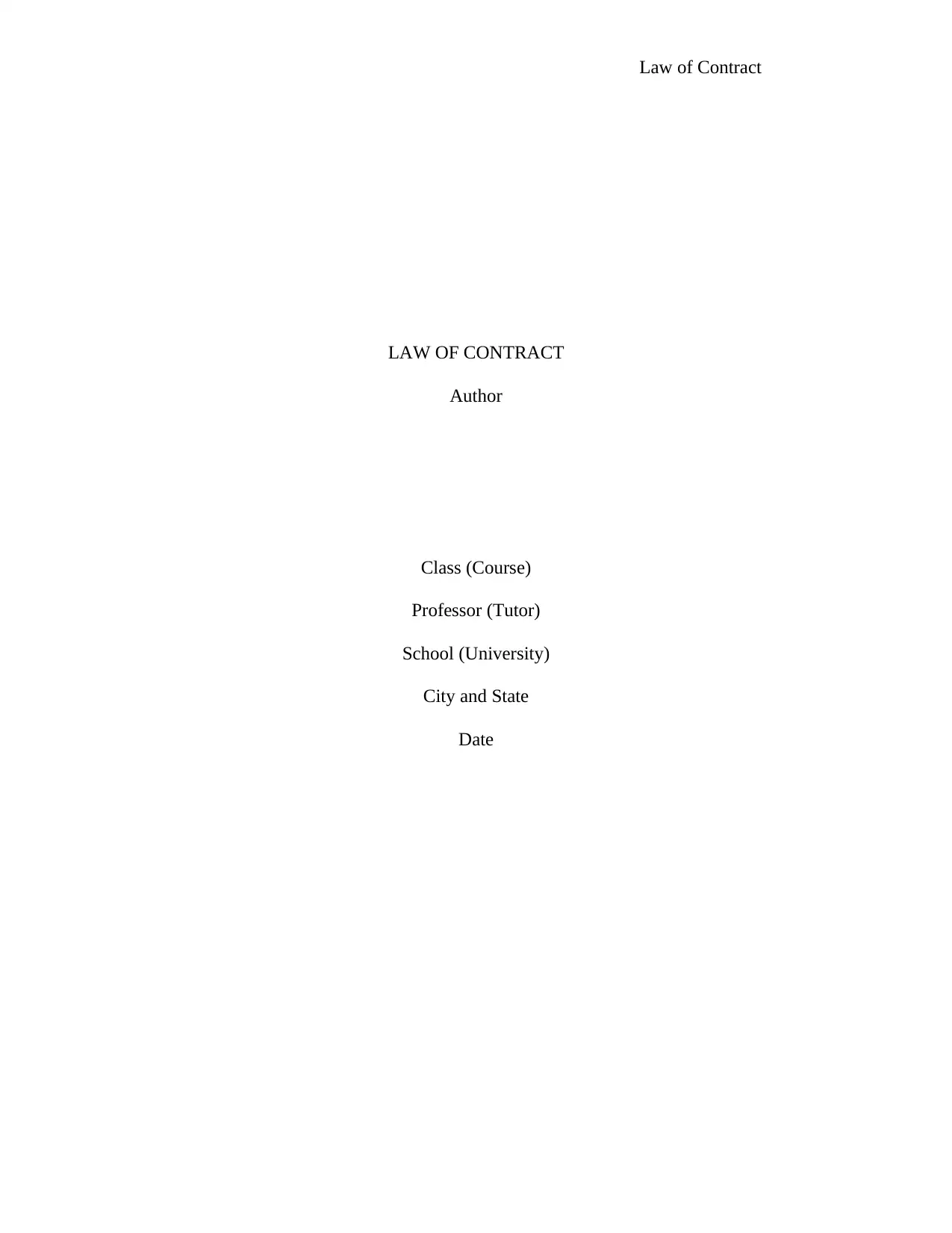
Law of Contract
LAW OF CONTRACT
Author
Class (Course)
Professor (Tutor)
School (University)
City and State
Date
LAW OF CONTRACT
Author
Class (Course)
Professor (Tutor)
School (University)
City and State
Date
Secure Best Marks with AI Grader
Need help grading? Try our AI Grader for instant feedback on your assignments.
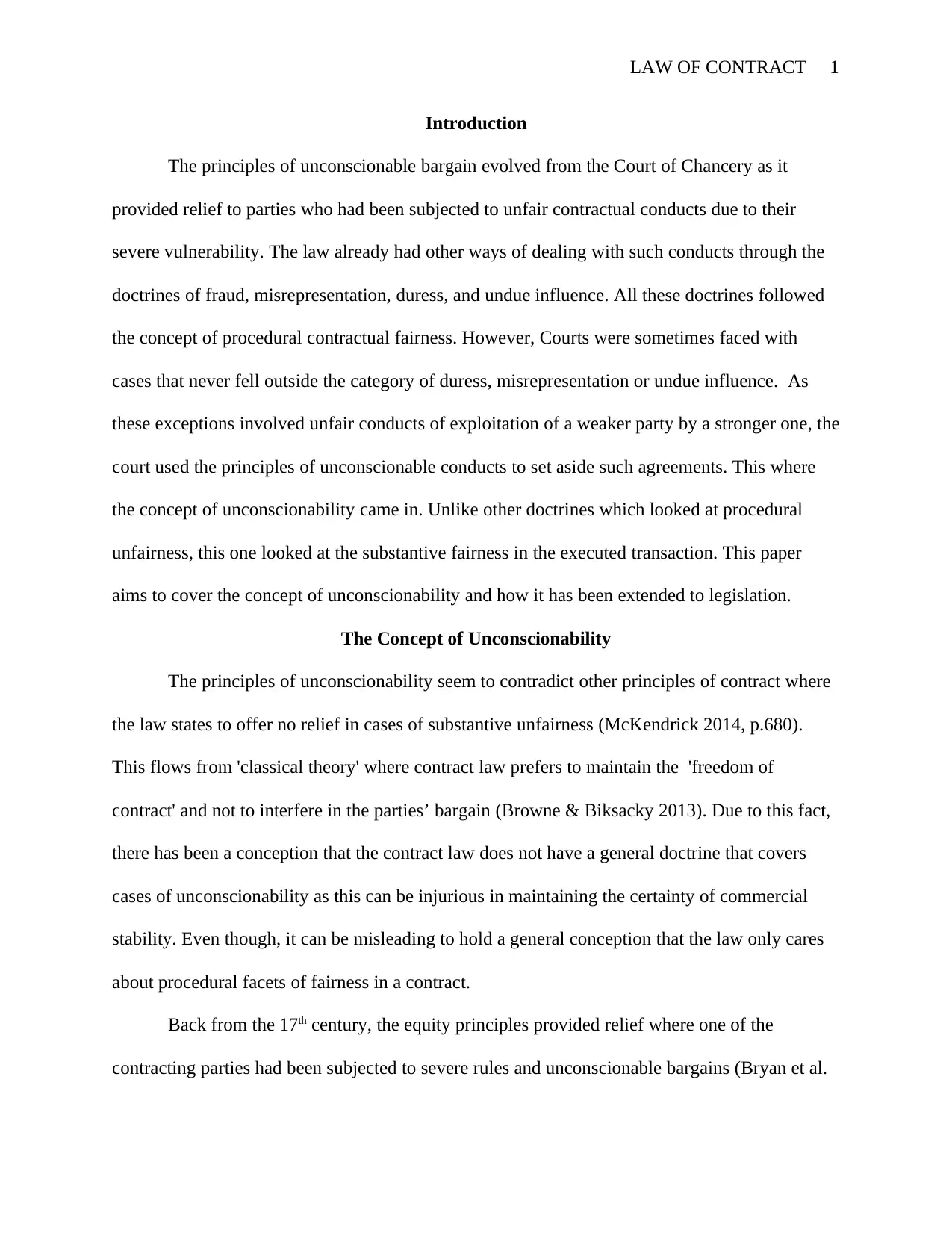
LAW OF CONTRACT 1
Introduction
The principles of unconscionable bargain evolved from the Court of Chancery as it
provided relief to parties who had been subjected to unfair contractual conducts due to their
severe vulnerability. The law already had other ways of dealing with such conducts through the
doctrines of fraud, misrepresentation, duress, and undue influence. All these doctrines followed
the concept of procedural contractual fairness. However, Courts were sometimes faced with
cases that never fell outside the category of duress, misrepresentation or undue influence. As
these exceptions involved unfair conducts of exploitation of a weaker party by a stronger one, the
court used the principles of unconscionable conducts to set aside such agreements. This where
the concept of unconscionability came in. Unlike other doctrines which looked at procedural
unfairness, this one looked at the substantive fairness in the executed transaction. This paper
aims to cover the concept of unconscionability and how it has been extended to legislation.
The Concept of Unconscionability
The principles of unconscionability seem to contradict other principles of contract where
the law states to offer no relief in cases of substantive unfairness (McKendrick 2014, p.680).
This flows from 'classical theory' where contract law prefers to maintain the 'freedom of
contract' and not to interfere in the parties’ bargain (Browne & Biksacky 2013). Due to this fact,
there has been a conception that the contract law does not have a general doctrine that covers
cases of unconscionability as this can be injurious in maintaining the certainty of commercial
stability. Even though, it can be misleading to hold a general conception that the law only cares
about procedural facets of fairness in a contract.
Back from the 17th century, the equity principles provided relief where one of the
contracting parties had been subjected to severe rules and unconscionable bargains (Bryan et al.
Introduction
The principles of unconscionable bargain evolved from the Court of Chancery as it
provided relief to parties who had been subjected to unfair contractual conducts due to their
severe vulnerability. The law already had other ways of dealing with such conducts through the
doctrines of fraud, misrepresentation, duress, and undue influence. All these doctrines followed
the concept of procedural contractual fairness. However, Courts were sometimes faced with
cases that never fell outside the category of duress, misrepresentation or undue influence. As
these exceptions involved unfair conducts of exploitation of a weaker party by a stronger one, the
court used the principles of unconscionable conducts to set aside such agreements. This where
the concept of unconscionability came in. Unlike other doctrines which looked at procedural
unfairness, this one looked at the substantive fairness in the executed transaction. This paper
aims to cover the concept of unconscionability and how it has been extended to legislation.
The Concept of Unconscionability
The principles of unconscionability seem to contradict other principles of contract where
the law states to offer no relief in cases of substantive unfairness (McKendrick 2014, p.680).
This flows from 'classical theory' where contract law prefers to maintain the 'freedom of
contract' and not to interfere in the parties’ bargain (Browne & Biksacky 2013). Due to this fact,
there has been a conception that the contract law does not have a general doctrine that covers
cases of unconscionability as this can be injurious in maintaining the certainty of commercial
stability. Even though, it can be misleading to hold a general conception that the law only cares
about procedural facets of fairness in a contract.
Back from the 17th century, the equity principles provided relief where one of the
contracting parties had been subjected to severe rules and unconscionable bargains (Bryan et al.
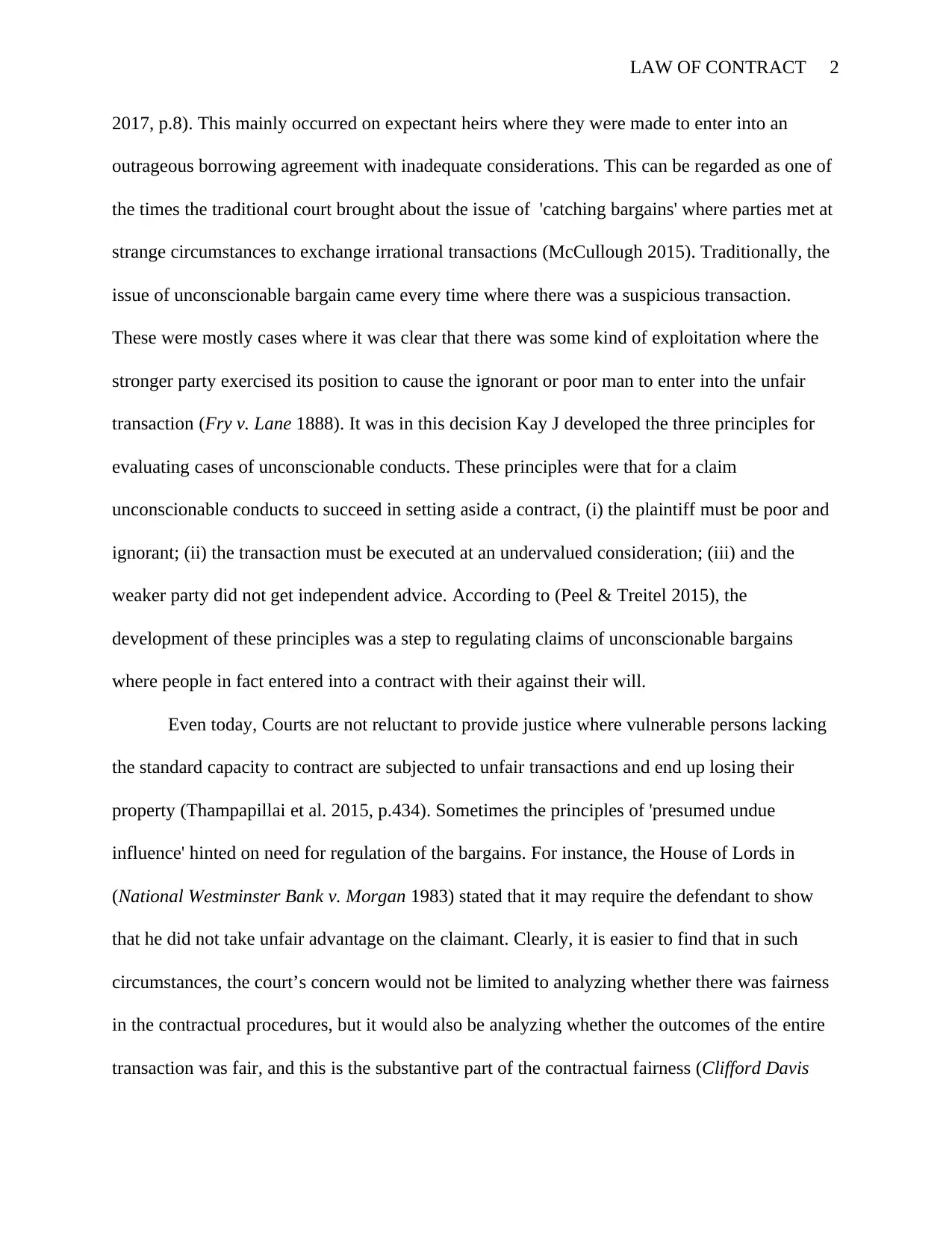
LAW OF CONTRACT 2
2017, p.8). This mainly occurred on expectant heirs where they were made to enter into an
outrageous borrowing agreement with inadequate considerations. This can be regarded as one of
the times the traditional court brought about the issue of 'catching bargains' where parties met at
strange circumstances to exchange irrational transactions (McCullough 2015). Traditionally, the
issue of unconscionable bargain came every time where there was a suspicious transaction.
These were mostly cases where it was clear that there was some kind of exploitation where the
stronger party exercised its position to cause the ignorant or poor man to enter into the unfair
transaction (Fry v. Lane 1888). It was in this decision Kay J developed the three principles for
evaluating cases of unconscionable conducts. These principles were that for a claim
unconscionable conducts to succeed in setting aside a contract, (i) the plaintiff must be poor and
ignorant; (ii) the transaction must be executed at an undervalued consideration; (iii) and the
weaker party did not get independent advice. According to (Peel & Treitel 2015), the
development of these principles was a step to regulating claims of unconscionable bargains
where people in fact entered into a contract with their against their will.
Even today, Courts are not reluctant to provide justice where vulnerable persons lacking
the standard capacity to contract are subjected to unfair transactions and end up losing their
property (Thampapillai et al. 2015, p.434). Sometimes the principles of 'presumed undue
influence' hinted on need for regulation of the bargains. For instance, the House of Lords in
(National Westminster Bank v. Morgan 1983) stated that it may require the defendant to show
that he did not take unfair advantage on the claimant. Clearly, it is easier to find that in such
circumstances, the court’s concern would not be limited to analyzing whether there was fairness
in the contractual procedures, but it would also be analyzing whether the outcomes of the entire
transaction was fair, and this is the substantive part of the contractual fairness (Clifford Davis
2017, p.8). This mainly occurred on expectant heirs where they were made to enter into an
outrageous borrowing agreement with inadequate considerations. This can be regarded as one of
the times the traditional court brought about the issue of 'catching bargains' where parties met at
strange circumstances to exchange irrational transactions (McCullough 2015). Traditionally, the
issue of unconscionable bargain came every time where there was a suspicious transaction.
These were mostly cases where it was clear that there was some kind of exploitation where the
stronger party exercised its position to cause the ignorant or poor man to enter into the unfair
transaction (Fry v. Lane 1888). It was in this decision Kay J developed the three principles for
evaluating cases of unconscionable conducts. These principles were that for a claim
unconscionable conducts to succeed in setting aside a contract, (i) the plaintiff must be poor and
ignorant; (ii) the transaction must be executed at an undervalued consideration; (iii) and the
weaker party did not get independent advice. According to (Peel & Treitel 2015), the
development of these principles was a step to regulating claims of unconscionable bargains
where people in fact entered into a contract with their against their will.
Even today, Courts are not reluctant to provide justice where vulnerable persons lacking
the standard capacity to contract are subjected to unfair transactions and end up losing their
property (Thampapillai et al. 2015, p.434). Sometimes the principles of 'presumed undue
influence' hinted on need for regulation of the bargains. For instance, the House of Lords in
(National Westminster Bank v. Morgan 1983) stated that it may require the defendant to show
that he did not take unfair advantage on the claimant. Clearly, it is easier to find that in such
circumstances, the court’s concern would not be limited to analyzing whether there was fairness
in the contractual procedures, but it would also be analyzing whether the outcomes of the entire
transaction was fair, and this is the substantive part of the contractual fairness (Clifford Davis
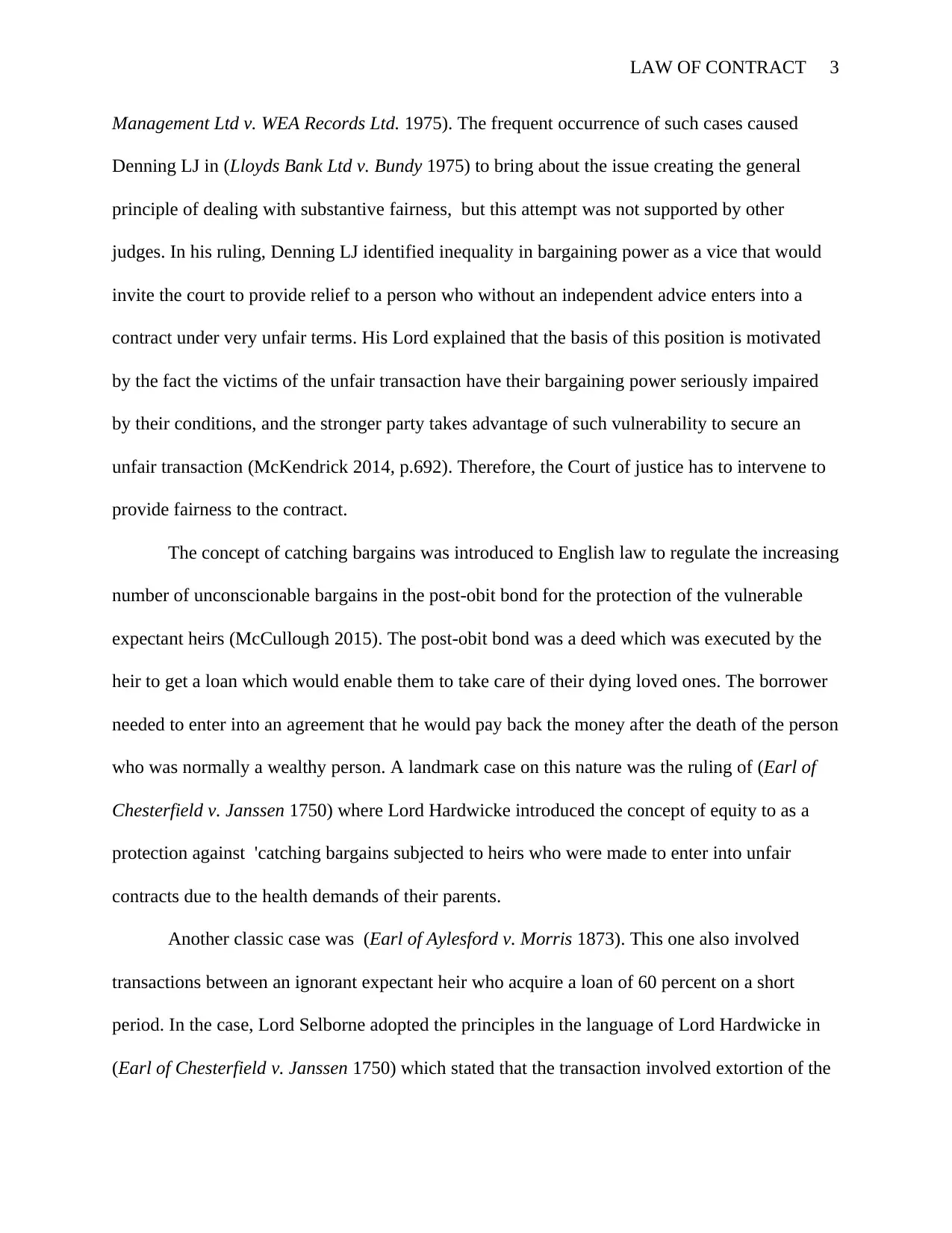
LAW OF CONTRACT 3
Management Ltd v. WEA Records Ltd. 1975). The frequent occurrence of such cases caused
Denning LJ in (Lloyds Bank Ltd v. Bundy 1975) to bring about the issue creating the general
principle of dealing with substantive fairness, but this attempt was not supported by other
judges. In his ruling, Denning LJ identified inequality in bargaining power as a vice that would
invite the court to provide relief to a person who without an independent advice enters into a
contract under very unfair terms. His Lord explained that the basis of this position is motivated
by the fact the victims of the unfair transaction have their bargaining power seriously impaired
by their conditions, and the stronger party takes advantage of such vulnerability to secure an
unfair transaction (McKendrick 2014, p.692). Therefore, the Court of justice has to intervene to
provide fairness to the contract.
The concept of catching bargains was introduced to English law to regulate the increasing
number of unconscionable bargains in the post-obit bond for the protection of the vulnerable
expectant heirs (McCullough 2015). The post-obit bond was a deed which was executed by the
heir to get a loan which would enable them to take care of their dying loved ones. The borrower
needed to enter into an agreement that he would pay back the money after the death of the person
who was normally a wealthy person. A landmark case on this nature was the ruling of (Earl of
Chesterfield v. Janssen 1750) where Lord Hardwicke introduced the concept of equity to as a
protection against 'catching bargains subjected to heirs who were made to enter into unfair
contracts due to the health demands of their parents.
Another classic case was (Earl of Aylesford v. Morris 1873). This one also involved
transactions between an ignorant expectant heir who acquire a loan of 60 percent on a short
period. In the case, Lord Selborne adopted the principles in the language of Lord Hardwicke in
(Earl of Chesterfield v. Janssen 1750) which stated that the transaction involved extortion of the
Management Ltd v. WEA Records Ltd. 1975). The frequent occurrence of such cases caused
Denning LJ in (Lloyds Bank Ltd v. Bundy 1975) to bring about the issue creating the general
principle of dealing with substantive fairness, but this attempt was not supported by other
judges. In his ruling, Denning LJ identified inequality in bargaining power as a vice that would
invite the court to provide relief to a person who without an independent advice enters into a
contract under very unfair terms. His Lord explained that the basis of this position is motivated
by the fact the victims of the unfair transaction have their bargaining power seriously impaired
by their conditions, and the stronger party takes advantage of such vulnerability to secure an
unfair transaction (McKendrick 2014, p.692). Therefore, the Court of justice has to intervene to
provide fairness to the contract.
The concept of catching bargains was introduced to English law to regulate the increasing
number of unconscionable bargains in the post-obit bond for the protection of the vulnerable
expectant heirs (McCullough 2015). The post-obit bond was a deed which was executed by the
heir to get a loan which would enable them to take care of their dying loved ones. The borrower
needed to enter into an agreement that he would pay back the money after the death of the person
who was normally a wealthy person. A landmark case on this nature was the ruling of (Earl of
Chesterfield v. Janssen 1750) where Lord Hardwicke introduced the concept of equity to as a
protection against 'catching bargains subjected to heirs who were made to enter into unfair
contracts due to the health demands of their parents.
Another classic case was (Earl of Aylesford v. Morris 1873). This one also involved
transactions between an ignorant expectant heir who acquire a loan of 60 percent on a short
period. In the case, Lord Selborne adopted the principles in the language of Lord Hardwicke in
(Earl of Chesterfield v. Janssen 1750) which stated that the transaction involved extortion of the
Secure Best Marks with AI Grader
Need help grading? Try our AI Grader for instant feedback on your assignments.
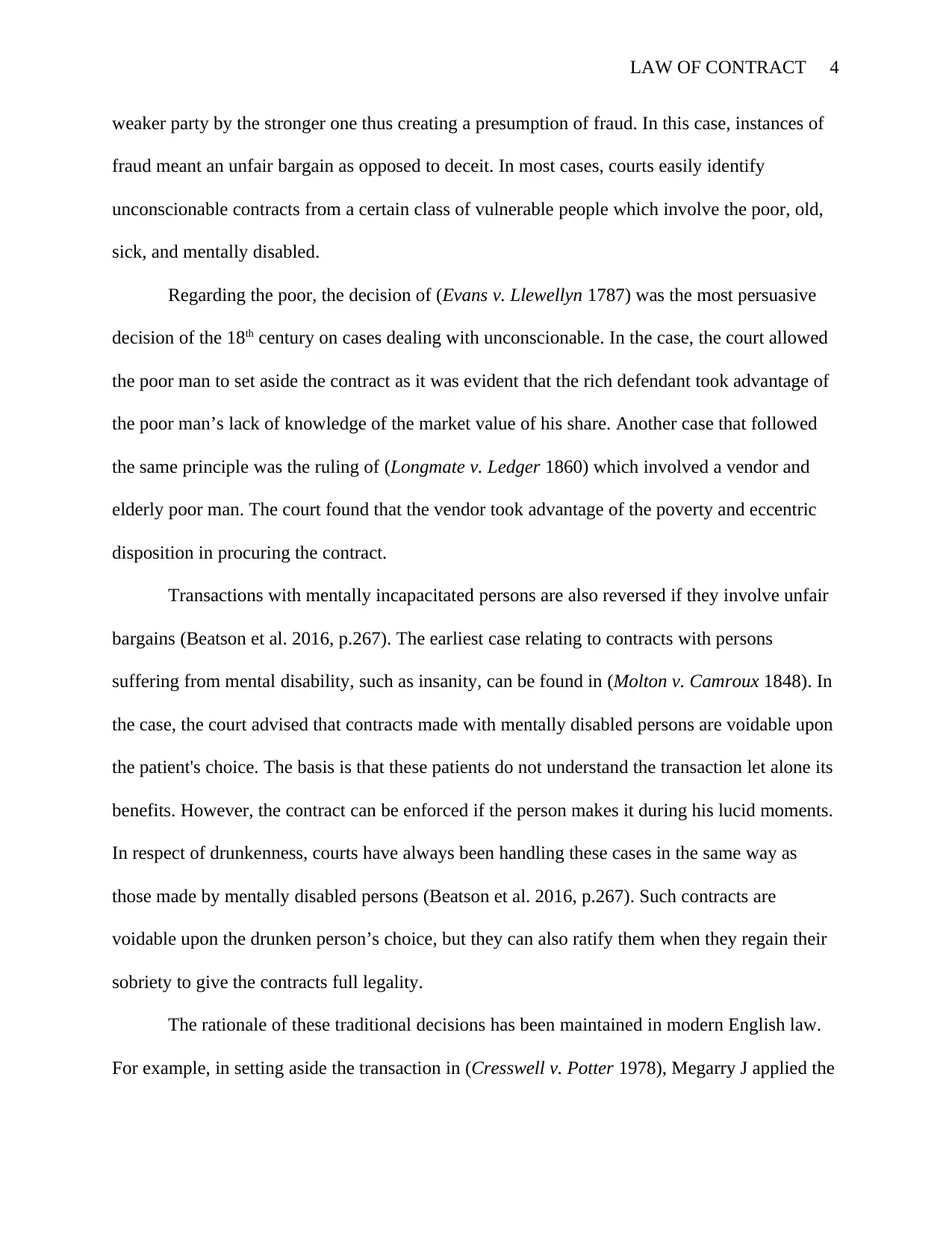
LAW OF CONTRACT 4
weaker party by the stronger one thus creating a presumption of fraud. In this case, instances of
fraud meant an unfair bargain as opposed to deceit. In most cases, courts easily identify
unconscionable contracts from a certain class of vulnerable people which involve the poor, old,
sick, and mentally disabled.
Regarding the poor, the decision of (Evans v. Llewellyn 1787) was the most persuasive
decision of the 18th century on cases dealing with unconscionable. In the case, the court allowed
the poor man to set aside the contract as it was evident that the rich defendant took advantage of
the poor man’s lack of knowledge of the market value of his share. Another case that followed
the same principle was the ruling of (Longmate v. Ledger 1860) which involved a vendor and
elderly poor man. The court found that the vendor took advantage of the poverty and eccentric
disposition in procuring the contract.
Transactions with mentally incapacitated persons are also reversed if they involve unfair
bargains (Beatson et al. 2016, p.267). The earliest case relating to contracts with persons
suffering from mental disability, such as insanity, can be found in (Molton v. Camroux 1848). In
the case, the court advised that contracts made with mentally disabled persons are voidable upon
the patient's choice. The basis is that these patients do not understand the transaction let alone its
benefits. However, the contract can be enforced if the person makes it during his lucid moments.
In respect of drunkenness, courts have always been handling these cases in the same way as
those made by mentally disabled persons (Beatson et al. 2016, p.267). Such contracts are
voidable upon the drunken person’s choice, but they can also ratify them when they regain their
sobriety to give the contracts full legality.
The rationale of these traditional decisions has been maintained in modern English law.
For example, in setting aside the transaction in (Cresswell v. Potter 1978), Megarry J applied the
weaker party by the stronger one thus creating a presumption of fraud. In this case, instances of
fraud meant an unfair bargain as opposed to deceit. In most cases, courts easily identify
unconscionable contracts from a certain class of vulnerable people which involve the poor, old,
sick, and mentally disabled.
Regarding the poor, the decision of (Evans v. Llewellyn 1787) was the most persuasive
decision of the 18th century on cases dealing with unconscionable. In the case, the court allowed
the poor man to set aside the contract as it was evident that the rich defendant took advantage of
the poor man’s lack of knowledge of the market value of his share. Another case that followed
the same principle was the ruling of (Longmate v. Ledger 1860) which involved a vendor and
elderly poor man. The court found that the vendor took advantage of the poverty and eccentric
disposition in procuring the contract.
Transactions with mentally incapacitated persons are also reversed if they involve unfair
bargains (Beatson et al. 2016, p.267). The earliest case relating to contracts with persons
suffering from mental disability, such as insanity, can be found in (Molton v. Camroux 1848). In
the case, the court advised that contracts made with mentally disabled persons are voidable upon
the patient's choice. The basis is that these patients do not understand the transaction let alone its
benefits. However, the contract can be enforced if the person makes it during his lucid moments.
In respect of drunkenness, courts have always been handling these cases in the same way as
those made by mentally disabled persons (Beatson et al. 2016, p.267). Such contracts are
voidable upon the drunken person’s choice, but they can also ratify them when they regain their
sobriety to give the contracts full legality.
The rationale of these traditional decisions has been maintained in modern English law.
For example, in setting aside the transaction in (Cresswell v. Potter 1978), Megarry J applied the
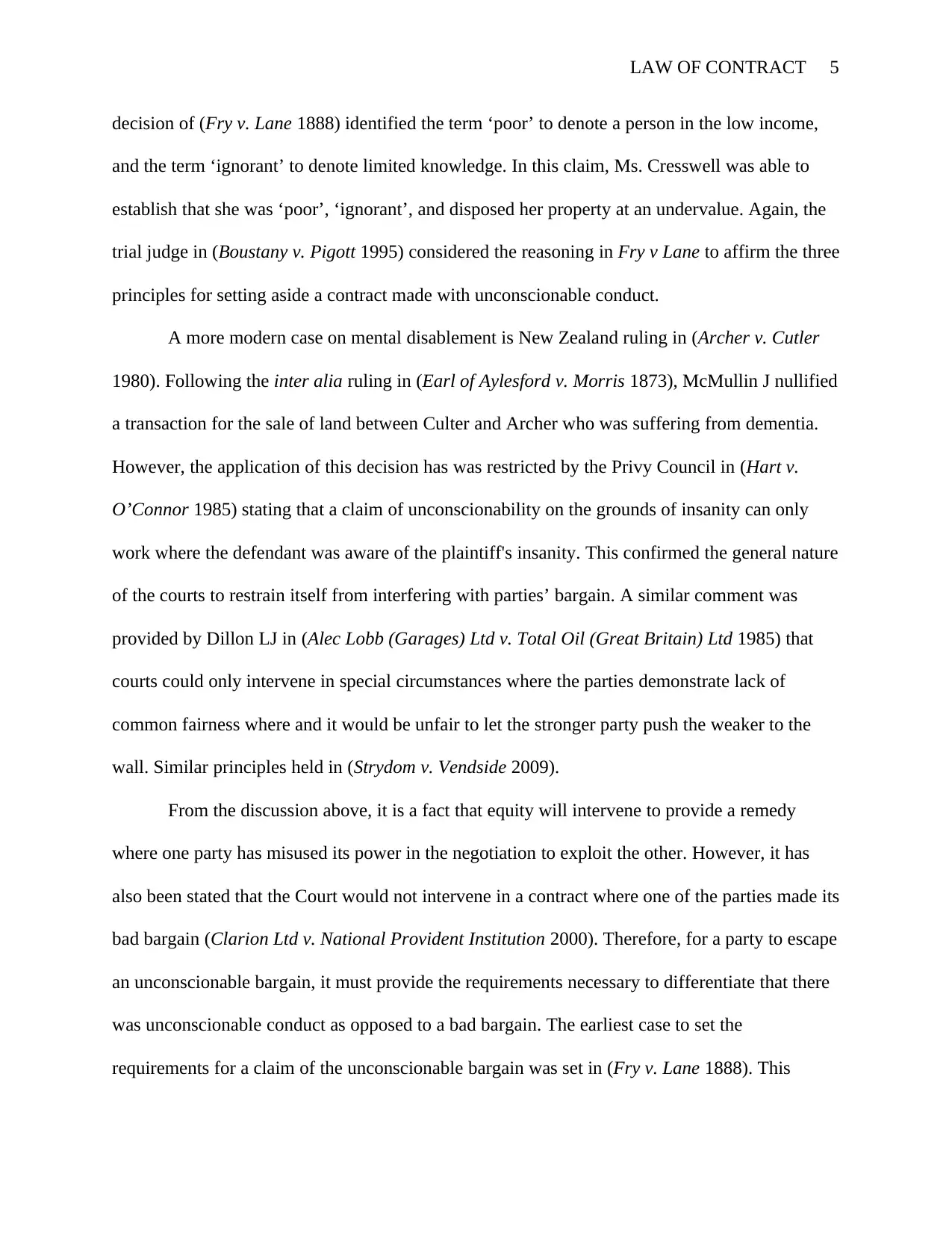
LAW OF CONTRACT 5
decision of (Fry v. Lane 1888) identified the term ‘poor’ to denote a person in the low income,
and the term ‘ignorant’ to denote limited knowledge. In this claim, Ms. Cresswell was able to
establish that she was ‘poor’, ‘ignorant’, and disposed her property at an undervalue. Again, the
trial judge in (Boustany v. Pigott 1995) considered the reasoning in Fry v Lane to affirm the three
principles for setting aside a contract made with unconscionable conduct.
A more modern case on mental disablement is New Zealand ruling in (Archer v. Cutler
1980). Following the inter alia ruling in (Earl of Aylesford v. Morris 1873), McMullin J nullified
a transaction for the sale of land between Culter and Archer who was suffering from dementia.
However, the application of this decision has was restricted by the Privy Council in (Hart v.
O’Connor 1985) stating that a claim of unconscionability on the grounds of insanity can only
work where the defendant was aware of the plaintiff's insanity. This confirmed the general nature
of the courts to restrain itself from interfering with parties’ bargain. A similar comment was
provided by Dillon LJ in (Alec Lobb (Garages) Ltd v. Total Oil (Great Britain) Ltd 1985) that
courts could only intervene in special circumstances where the parties demonstrate lack of
common fairness where and it would be unfair to let the stronger party push the weaker to the
wall. Similar principles held in (Strydom v. Vendside 2009).
From the discussion above, it is a fact that equity will intervene to provide a remedy
where one party has misused its power in the negotiation to exploit the other. However, it has
also been stated that the Court would not intervene in a contract where one of the parties made its
bad bargain (Clarion Ltd v. National Provident Institution 2000). Therefore, for a party to escape
an unconscionable bargain, it must provide the requirements necessary to differentiate that there
was unconscionable conduct as opposed to a bad bargain. The earliest case to set the
requirements for a claim of the unconscionable bargain was set in (Fry v. Lane 1888). This
decision of (Fry v. Lane 1888) identified the term ‘poor’ to denote a person in the low income,
and the term ‘ignorant’ to denote limited knowledge. In this claim, Ms. Cresswell was able to
establish that she was ‘poor’, ‘ignorant’, and disposed her property at an undervalue. Again, the
trial judge in (Boustany v. Pigott 1995) considered the reasoning in Fry v Lane to affirm the three
principles for setting aside a contract made with unconscionable conduct.
A more modern case on mental disablement is New Zealand ruling in (Archer v. Cutler
1980). Following the inter alia ruling in (Earl of Aylesford v. Morris 1873), McMullin J nullified
a transaction for the sale of land between Culter and Archer who was suffering from dementia.
However, the application of this decision has was restricted by the Privy Council in (Hart v.
O’Connor 1985) stating that a claim of unconscionability on the grounds of insanity can only
work where the defendant was aware of the plaintiff's insanity. This confirmed the general nature
of the courts to restrain itself from interfering with parties’ bargain. A similar comment was
provided by Dillon LJ in (Alec Lobb (Garages) Ltd v. Total Oil (Great Britain) Ltd 1985) that
courts could only intervene in special circumstances where the parties demonstrate lack of
common fairness where and it would be unfair to let the stronger party push the weaker to the
wall. Similar principles held in (Strydom v. Vendside 2009).
From the discussion above, it is a fact that equity will intervene to provide a remedy
where one party has misused its power in the negotiation to exploit the other. However, it has
also been stated that the Court would not intervene in a contract where one of the parties made its
bad bargain (Clarion Ltd v. National Provident Institution 2000). Therefore, for a party to escape
an unconscionable bargain, it must provide the requirements necessary to differentiate that there
was unconscionable conduct as opposed to a bad bargain. The earliest case to set the
requirements for a claim of the unconscionable bargain was set in (Fry v. Lane 1888). This
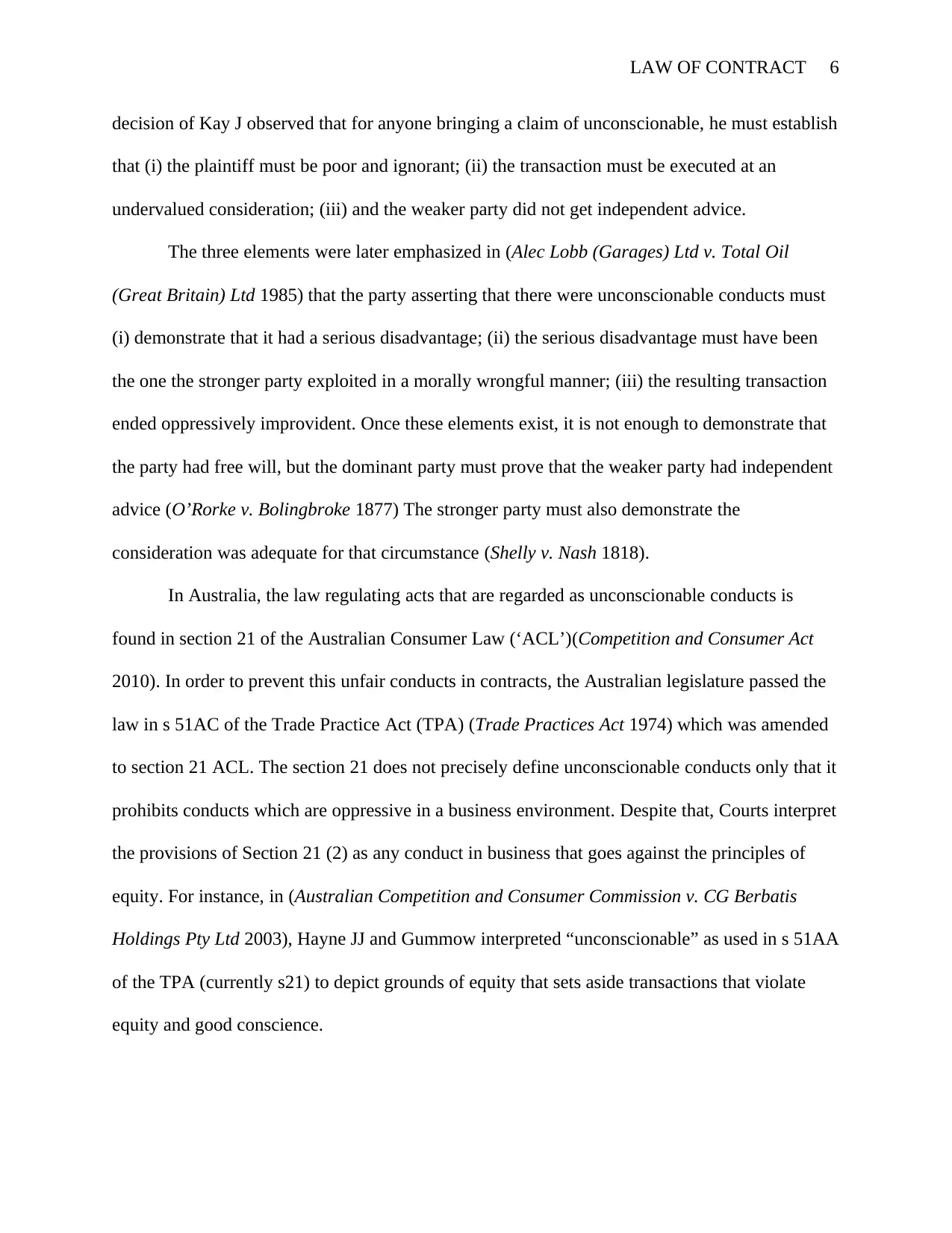
LAW OF CONTRACT 6
decision of Kay J observed that for anyone bringing a claim of unconscionable, he must establish
that (i) the plaintiff must be poor and ignorant; (ii) the transaction must be executed at an
undervalued consideration; (iii) and the weaker party did not get independent advice.
The three elements were later emphasized in (Alec Lobb (Garages) Ltd v. Total Oil
(Great Britain) Ltd 1985) that the party asserting that there were unconscionable conducts must
(i) demonstrate that it had a serious disadvantage; (ii) the serious disadvantage must have been
the one the stronger party exploited in a morally wrongful manner; (iii) the resulting transaction
ended oppressively improvident. Once these elements exist, it is not enough to demonstrate that
the party had free will, but the dominant party must prove that the weaker party had independent
advice (O’Rorke v. Bolingbroke 1877) The stronger party must also demonstrate the
consideration was adequate for that circumstance (Shelly v. Nash 1818).
In Australia, the law regulating acts that are regarded as unconscionable conducts is
found in section 21 of the Australian Consumer Law (‘ACL’)(Competition and Consumer Act
2010). In order to prevent this unfair conducts in contracts, the Australian legislature passed the
law in s 51AC of the Trade Practice Act (TPA) (Trade Practices Act 1974) which was amended
to section 21 ACL. The section 21 does not precisely define unconscionable conducts only that it
prohibits conducts which are oppressive in a business environment. Despite that, Courts interpret
the provisions of Section 21 (2) as any conduct in business that goes against the principles of
equity. For instance, in (Australian Competition and Consumer Commission v. CG Berbatis
Holdings Pty Ltd 2003), Hayne JJ and Gummow interpreted “unconscionable” as used in s 51AA
of the TPA (currently s21) to depict grounds of equity that sets aside transactions that violate
equity and good conscience.
decision of Kay J observed that for anyone bringing a claim of unconscionable, he must establish
that (i) the plaintiff must be poor and ignorant; (ii) the transaction must be executed at an
undervalued consideration; (iii) and the weaker party did not get independent advice.
The three elements were later emphasized in (Alec Lobb (Garages) Ltd v. Total Oil
(Great Britain) Ltd 1985) that the party asserting that there were unconscionable conducts must
(i) demonstrate that it had a serious disadvantage; (ii) the serious disadvantage must have been
the one the stronger party exploited in a morally wrongful manner; (iii) the resulting transaction
ended oppressively improvident. Once these elements exist, it is not enough to demonstrate that
the party had free will, but the dominant party must prove that the weaker party had independent
advice (O’Rorke v. Bolingbroke 1877) The stronger party must also demonstrate the
consideration was adequate for that circumstance (Shelly v. Nash 1818).
In Australia, the law regulating acts that are regarded as unconscionable conducts is
found in section 21 of the Australian Consumer Law (‘ACL’)(Competition and Consumer Act
2010). In order to prevent this unfair conducts in contracts, the Australian legislature passed the
law in s 51AC of the Trade Practice Act (TPA) (Trade Practices Act 1974) which was amended
to section 21 ACL. The section 21 does not precisely define unconscionable conducts only that it
prohibits conducts which are oppressive in a business environment. Despite that, Courts interpret
the provisions of Section 21 (2) as any conduct in business that goes against the principles of
equity. For instance, in (Australian Competition and Consumer Commission v. CG Berbatis
Holdings Pty Ltd 2003), Hayne JJ and Gummow interpreted “unconscionable” as used in s 51AA
of the TPA (currently s21) to depict grounds of equity that sets aside transactions that violate
equity and good conscience.
Paraphrase This Document
Need a fresh take? Get an instant paraphrase of this document with our AI Paraphraser
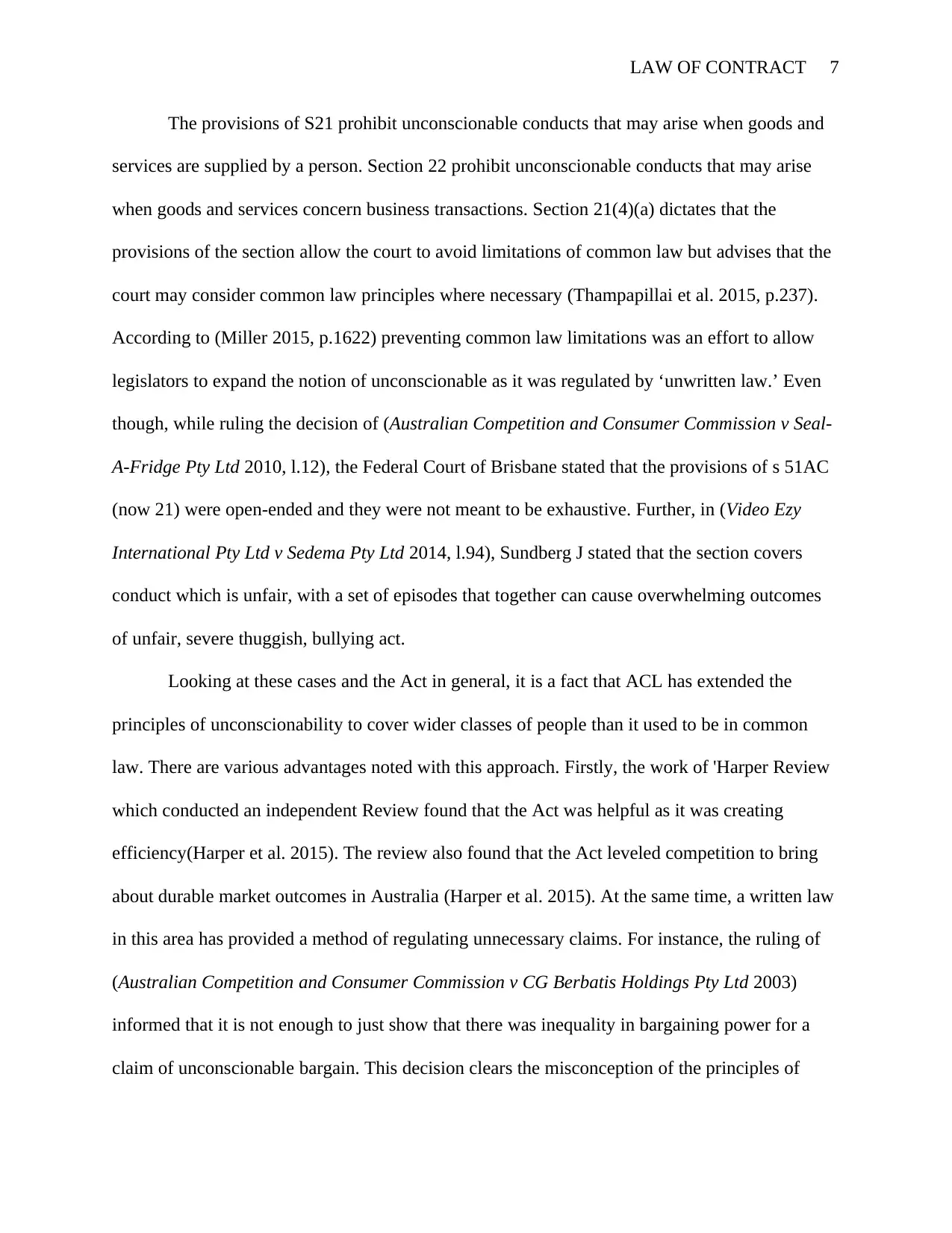
LAW OF CONTRACT 7
The provisions of S21 prohibit unconscionable conducts that may arise when goods and
services are supplied by a person. Section 22 prohibit unconscionable conducts that may arise
when goods and services concern business transactions. Section 21(4)(a) dictates that the
provisions of the section allow the court to avoid limitations of common law but advises that the
court may consider common law principles where necessary (Thampapillai et al. 2015, p.237).
According to (Miller 2015, p.1622) preventing common law limitations was an effort to allow
legislators to expand the notion of unconscionable as it was regulated by ‘unwritten law.’ Even
though, while ruling the decision of (Australian Competition and Consumer Commission v Seal-
A-Fridge Pty Ltd 2010, l.12), the Federal Court of Brisbane stated that the provisions of s 51AC
(now 21) were open-ended and they were not meant to be exhaustive. Further, in (Video Ezy
International Pty Ltd v Sedema Pty Ltd 2014, l.94), Sundberg J stated that the section covers
conduct which is unfair, with a set of episodes that together can cause overwhelming outcomes
of unfair, severe thuggish, bullying act.
Looking at these cases and the Act in general, it is a fact that ACL has extended the
principles of unconscionability to cover wider classes of people than it used to be in common
law. There are various advantages noted with this approach. Firstly, the work of 'Harper Review
which conducted an independent Review found that the Act was helpful as it was creating
efficiency(Harper et al. 2015). The review also found that the Act leveled competition to bring
about durable market outcomes in Australia (Harper et al. 2015). At the same time, a written law
in this area has provided a method of regulating unnecessary claims. For instance, the ruling of
(Australian Competition and Consumer Commission v CG Berbatis Holdings Pty Ltd 2003)
informed that it is not enough to just show that there was inequality in bargaining power for a
claim of unconscionable bargain. This decision clears the misconception of the principles of
The provisions of S21 prohibit unconscionable conducts that may arise when goods and
services are supplied by a person. Section 22 prohibit unconscionable conducts that may arise
when goods and services concern business transactions. Section 21(4)(a) dictates that the
provisions of the section allow the court to avoid limitations of common law but advises that the
court may consider common law principles where necessary (Thampapillai et al. 2015, p.237).
According to (Miller 2015, p.1622) preventing common law limitations was an effort to allow
legislators to expand the notion of unconscionable as it was regulated by ‘unwritten law.’ Even
though, while ruling the decision of (Australian Competition and Consumer Commission v Seal-
A-Fridge Pty Ltd 2010, l.12), the Federal Court of Brisbane stated that the provisions of s 51AC
(now 21) were open-ended and they were not meant to be exhaustive. Further, in (Video Ezy
International Pty Ltd v Sedema Pty Ltd 2014, l.94), Sundberg J stated that the section covers
conduct which is unfair, with a set of episodes that together can cause overwhelming outcomes
of unfair, severe thuggish, bullying act.
Looking at these cases and the Act in general, it is a fact that ACL has extended the
principles of unconscionability to cover wider classes of people than it used to be in common
law. There are various advantages noted with this approach. Firstly, the work of 'Harper Review
which conducted an independent Review found that the Act was helpful as it was creating
efficiency(Harper et al. 2015). The review also found that the Act leveled competition to bring
about durable market outcomes in Australia (Harper et al. 2015). At the same time, a written law
in this area has provided a method of regulating unnecessary claims. For instance, the ruling of
(Australian Competition and Consumer Commission v CG Berbatis Holdings Pty Ltd 2003)
informed that it is not enough to just show that there was inequality in bargaining power for a
claim of unconscionable bargain. This decision clears the misconception of the principles of
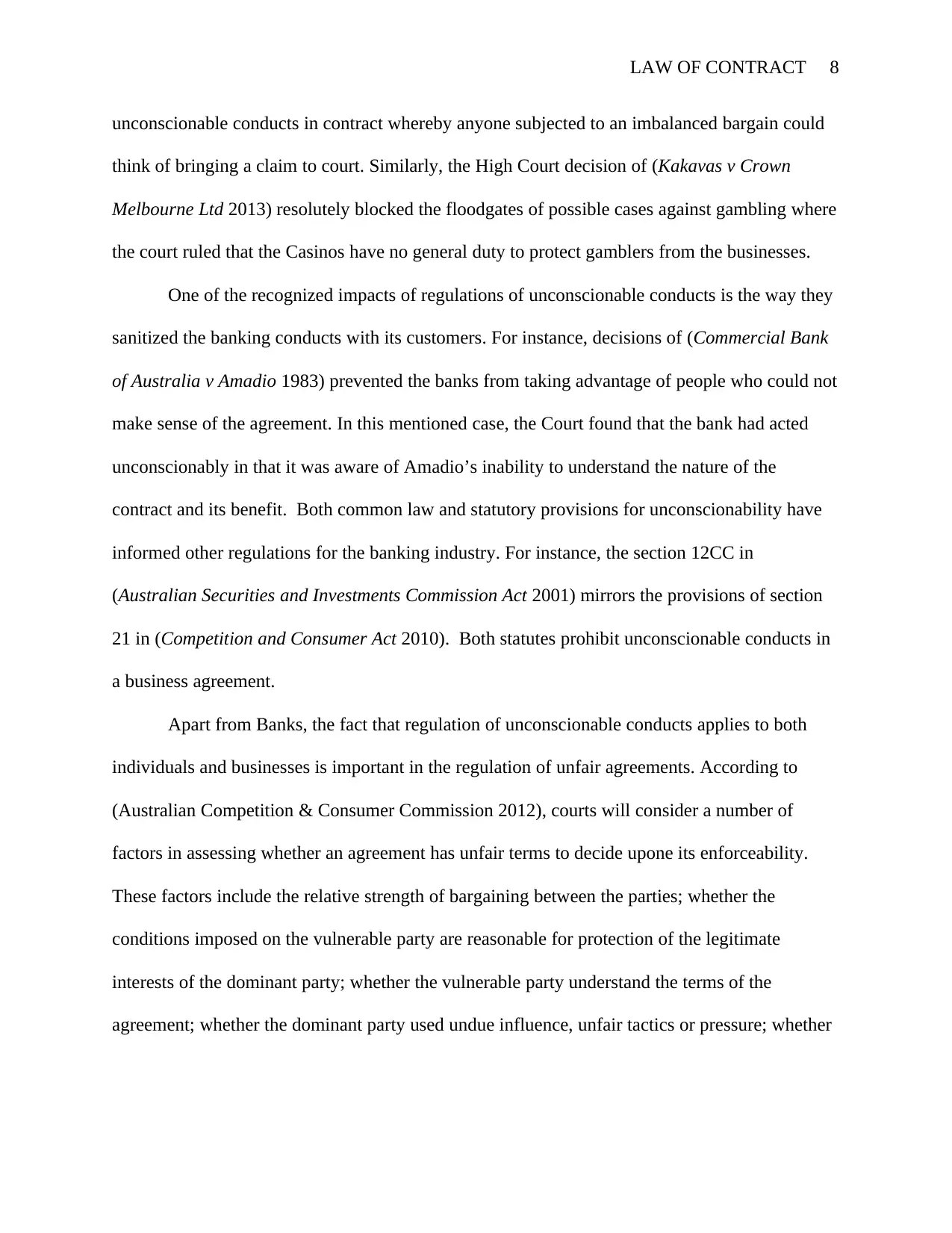
LAW OF CONTRACT 8
unconscionable conducts in contract whereby anyone subjected to an imbalanced bargain could
think of bringing a claim to court. Similarly, the High Court decision of (Kakavas v Crown
Melbourne Ltd 2013) resolutely blocked the floodgates of possible cases against gambling where
the court ruled that the Casinos have no general duty to protect gamblers from the businesses.
One of the recognized impacts of regulations of unconscionable conducts is the way they
sanitized the banking conducts with its customers. For instance, decisions of (Commercial Bank
of Australia v Amadio 1983) prevented the banks from taking advantage of people who could not
make sense of the agreement. In this mentioned case, the Court found that the bank had acted
unconscionably in that it was aware of Amadio’s inability to understand the nature of the
contract and its benefit. Both common law and statutory provisions for unconscionability have
informed other regulations for the banking industry. For instance, the section 12CC in
(Australian Securities and Investments Commission Act 2001) mirrors the provisions of section
21 in (Competition and Consumer Act 2010). Both statutes prohibit unconscionable conducts in
a business agreement.
Apart from Banks, the fact that regulation of unconscionable conducts applies to both
individuals and businesses is important in the regulation of unfair agreements. According to
(Australian Competition & Consumer Commission 2012), courts will consider a number of
factors in assessing whether an agreement has unfair terms to decide upone its enforceability.
These factors include the relative strength of bargaining between the parties; whether the
conditions imposed on the vulnerable party are reasonable for protection of the legitimate
interests of the dominant party; whether the vulnerable party understand the terms of the
agreement; whether the dominant party used undue influence, unfair tactics or pressure; whether
unconscionable conducts in contract whereby anyone subjected to an imbalanced bargain could
think of bringing a claim to court. Similarly, the High Court decision of (Kakavas v Crown
Melbourne Ltd 2013) resolutely blocked the floodgates of possible cases against gambling where
the court ruled that the Casinos have no general duty to protect gamblers from the businesses.
One of the recognized impacts of regulations of unconscionable conducts is the way they
sanitized the banking conducts with its customers. For instance, decisions of (Commercial Bank
of Australia v Amadio 1983) prevented the banks from taking advantage of people who could not
make sense of the agreement. In this mentioned case, the Court found that the bank had acted
unconscionably in that it was aware of Amadio’s inability to understand the nature of the
contract and its benefit. Both common law and statutory provisions for unconscionability have
informed other regulations for the banking industry. For instance, the section 12CC in
(Australian Securities and Investments Commission Act 2001) mirrors the provisions of section
21 in (Competition and Consumer Act 2010). Both statutes prohibit unconscionable conducts in
a business agreement.
Apart from Banks, the fact that regulation of unconscionable conducts applies to both
individuals and businesses is important in the regulation of unfair agreements. According to
(Australian Competition & Consumer Commission 2012), courts will consider a number of
factors in assessing whether an agreement has unfair terms to decide upone its enforceability.
These factors include the relative strength of bargaining between the parties; whether the
conditions imposed on the vulnerable party are reasonable for protection of the legitimate
interests of the dominant party; whether the vulnerable party understand the terms of the
agreement; whether the dominant party used undue influence, unfair tactics or pressure; whether
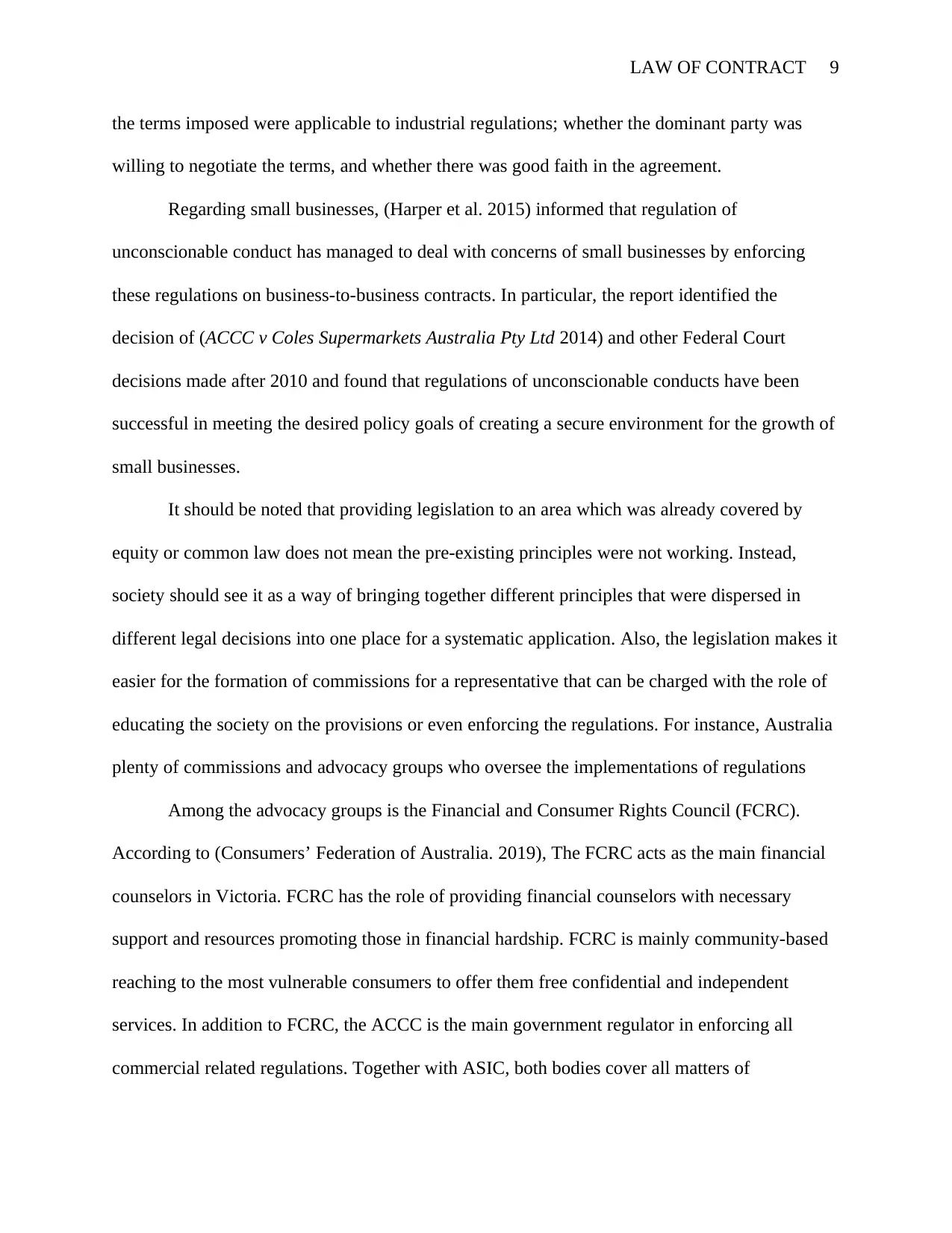
LAW OF CONTRACT 9
the terms imposed were applicable to industrial regulations; whether the dominant party was
willing to negotiate the terms, and whether there was good faith in the agreement.
Regarding small businesses, (Harper et al. 2015) informed that regulation of
unconscionable conduct has managed to deal with concerns of small businesses by enforcing
these regulations on business-to-business contracts. In particular, the report identified the
decision of (ACCC v Coles Supermarkets Australia Pty Ltd 2014) and other Federal Court
decisions made after 2010 and found that regulations of unconscionable conducts have been
successful in meeting the desired policy goals of creating a secure environment for the growth of
small businesses.
It should be noted that providing legislation to an area which was already covered by
equity or common law does not mean the pre-existing principles were not working. Instead,
society should see it as a way of bringing together different principles that were dispersed in
different legal decisions into one place for a systematic application. Also, the legislation makes it
easier for the formation of commissions for a representative that can be charged with the role of
educating the society on the provisions or even enforcing the regulations. For instance, Australia
plenty of commissions and advocacy groups who oversee the implementations of regulations
Among the advocacy groups is the Financial and Consumer Rights Council (FCRC).
According to (Consumers’ Federation of Australia. 2019), The FCRC acts as the main financial
counselors in Victoria. FCRC has the role of providing financial counselors with necessary
support and resources promoting those in financial hardship. FCRC is mainly community-based
reaching to the most vulnerable consumers to offer them free confidential and independent
services. In addition to FCRC, the ACCC is the main government regulator in enforcing all
commercial related regulations. Together with ASIC, both bodies cover all matters of
the terms imposed were applicable to industrial regulations; whether the dominant party was
willing to negotiate the terms, and whether there was good faith in the agreement.
Regarding small businesses, (Harper et al. 2015) informed that regulation of
unconscionable conduct has managed to deal with concerns of small businesses by enforcing
these regulations on business-to-business contracts. In particular, the report identified the
decision of (ACCC v Coles Supermarkets Australia Pty Ltd 2014) and other Federal Court
decisions made after 2010 and found that regulations of unconscionable conducts have been
successful in meeting the desired policy goals of creating a secure environment for the growth of
small businesses.
It should be noted that providing legislation to an area which was already covered by
equity or common law does not mean the pre-existing principles were not working. Instead,
society should see it as a way of bringing together different principles that were dispersed in
different legal decisions into one place for a systematic application. Also, the legislation makes it
easier for the formation of commissions for a representative that can be charged with the role of
educating the society on the provisions or even enforcing the regulations. For instance, Australia
plenty of commissions and advocacy groups who oversee the implementations of regulations
Among the advocacy groups is the Financial and Consumer Rights Council (FCRC).
According to (Consumers’ Federation of Australia. 2019), The FCRC acts as the main financial
counselors in Victoria. FCRC has the role of providing financial counselors with necessary
support and resources promoting those in financial hardship. FCRC is mainly community-based
reaching to the most vulnerable consumers to offer them free confidential and independent
services. In addition to FCRC, the ACCC is the main government regulator in enforcing all
commercial related regulations. Together with ASIC, both bodies cover all matters of
Secure Best Marks with AI Grader
Need help grading? Try our AI Grader for instant feedback on your assignments.
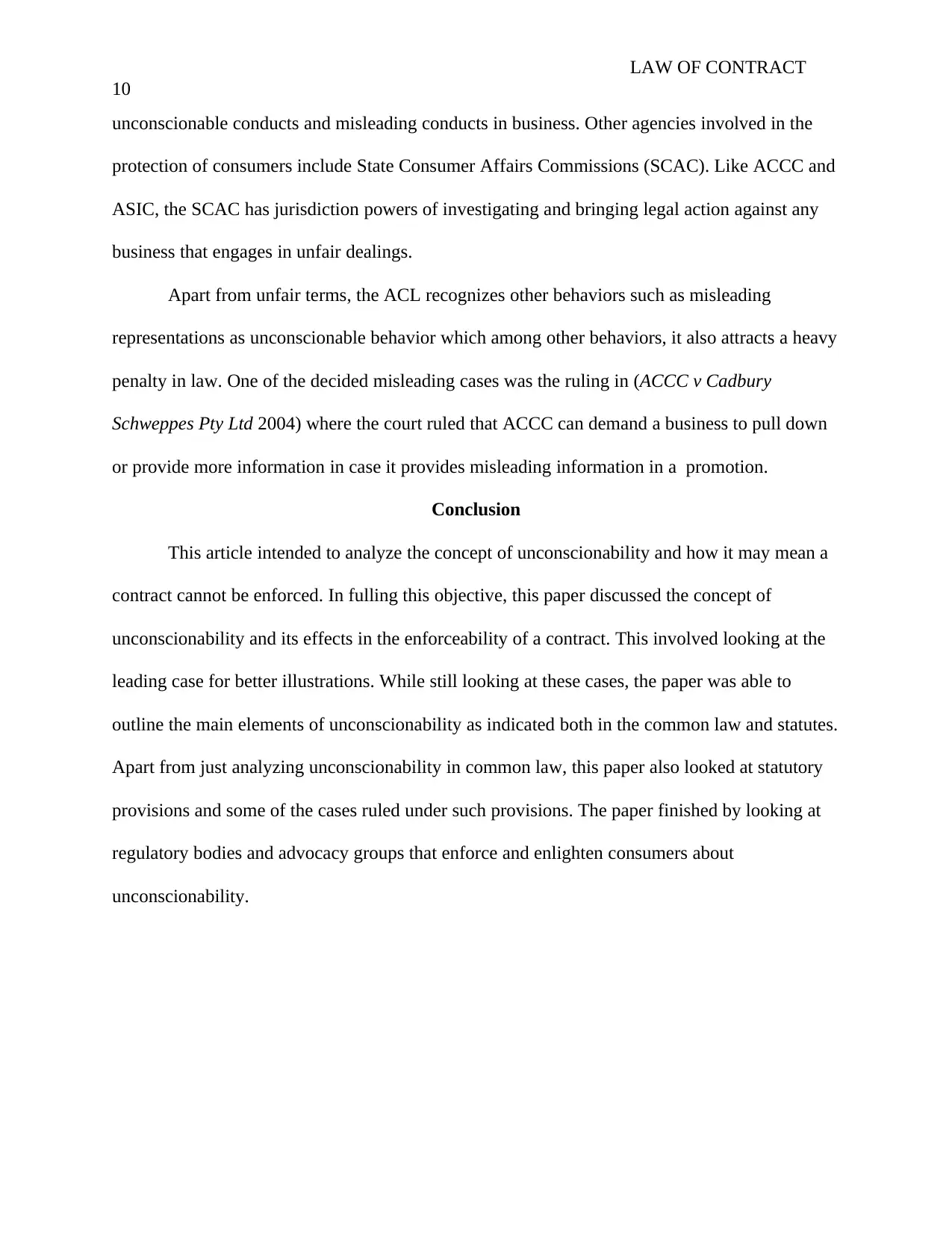
LAW OF CONTRACT
10
unconscionable conducts and misleading conducts in business. Other agencies involved in the
protection of consumers include State Consumer Affairs Commissions (SCAC). Like ACCC and
ASIC, the SCAC has jurisdiction powers of investigating and bringing legal action against any
business that engages in unfair dealings.
Apart from unfair terms, the ACL recognizes other behaviors such as misleading
representations as unconscionable behavior which among other behaviors, it also attracts a heavy
penalty in law. One of the decided misleading cases was the ruling in (ACCC v Cadbury
Schweppes Pty Ltd 2004) where the court ruled that ACCC can demand a business to pull down
or provide more information in case it provides misleading information in a promotion.
Conclusion
This article intended to analyze the concept of unconscionability and how it may mean a
contract cannot be enforced. In fulling this objective, this paper discussed the concept of
unconscionability and its effects in the enforceability of a contract. This involved looking at the
leading case for better illustrations. While still looking at these cases, the paper was able to
outline the main elements of unconscionability as indicated both in the common law and statutes.
Apart from just analyzing unconscionability in common law, this paper also looked at statutory
provisions and some of the cases ruled under such provisions. The paper finished by looking at
regulatory bodies and advocacy groups that enforce and enlighten consumers about
unconscionability.
10
unconscionable conducts and misleading conducts in business. Other agencies involved in the
protection of consumers include State Consumer Affairs Commissions (SCAC). Like ACCC and
ASIC, the SCAC has jurisdiction powers of investigating and bringing legal action against any
business that engages in unfair dealings.
Apart from unfair terms, the ACL recognizes other behaviors such as misleading
representations as unconscionable behavior which among other behaviors, it also attracts a heavy
penalty in law. One of the decided misleading cases was the ruling in (ACCC v Cadbury
Schweppes Pty Ltd 2004) where the court ruled that ACCC can demand a business to pull down
or provide more information in case it provides misleading information in a promotion.
Conclusion
This article intended to analyze the concept of unconscionability and how it may mean a
contract cannot be enforced. In fulling this objective, this paper discussed the concept of
unconscionability and its effects in the enforceability of a contract. This involved looking at the
leading case for better illustrations. While still looking at these cases, the paper was able to
outline the main elements of unconscionability as indicated both in the common law and statutes.
Apart from just analyzing unconscionability in common law, this paper also looked at statutory
provisions and some of the cases ruled under such provisions. The paper finished by looking at
regulatory bodies and advocacy groups that enforce and enlighten consumers about
unconscionability.

LAW OF CONTRACT
11
References
ACCC v Cadbury Schweppes Pty Ltd 2004.
ACCC v Coles Supermarkets Australia Pty Ltd 2014.
Alec Lobb (Garages) Ltd v. Total Oil (Great Britain) Ltd 1985.
Archer v. Cutler 1980.
Australian Competition & Consumer Commission 2012, Unconscionable conduct, Australian
Competition and Consumer Commission, viewed 30 April 2019,
<https://www.accc.gov.au/business/anti-competitive-behaviour/unconscionable-conduct>.
Australian Competition and Consumer Commission v. CG Berbatis Holdings Pty Ltd 2003.
Australian Competition and Consumer Commission v CG Berbatis Holdings Pty Ltd 2003.
Australian Competition and Consumer Commission v Seal-A-Fridge Pty Ltd 2010.
Australian Securities and Investments Commission [ASIC] Act 2001.
Beatson, J et al. 2016, Anson’s law of contract, 30th edition, Oxford University Press, Oxford,
United Kingdom.
Boustany v. Pigott 1995.
Browne, MN & Biksacky, L 2013, ‘Unconscionability and the contingent assumptions of
contract theory’, Mich. St. L. Rev., p. 211.
Bryan, M, Vann, VJ, & Barkehall Thomas, S 2017, Equity and trusts in Australia, Second
edition, Cambridge University Press, Cambridge ; Port Melbourne, Vic.
Clarion Ltd v. National Provident Institution 2000.
Clifford Davis Management Ltd v. WEA Records Ltd. 1975.
Commercial Bank of Australia v Amadio 1983.
Competition and Consumer Act [CCA] 2010.
Consumers’ Federation of Australia [CFA]. 2019, ‘Financial and Consumer Rights Council -
Consumers’ Federation of Australia’, viewed 30 April 2019,
<http://consumersfederation.org.au/financial-and-consumer-rights-council/>.
Cresswell v. Potter 1978.
Earl of Aylesford v. Morris 1873.
11
References
ACCC v Cadbury Schweppes Pty Ltd 2004.
ACCC v Coles Supermarkets Australia Pty Ltd 2014.
Alec Lobb (Garages) Ltd v. Total Oil (Great Britain) Ltd 1985.
Archer v. Cutler 1980.
Australian Competition & Consumer Commission 2012, Unconscionable conduct, Australian
Competition and Consumer Commission, viewed 30 April 2019,
<https://www.accc.gov.au/business/anti-competitive-behaviour/unconscionable-conduct>.
Australian Competition and Consumer Commission v. CG Berbatis Holdings Pty Ltd 2003.
Australian Competition and Consumer Commission v CG Berbatis Holdings Pty Ltd 2003.
Australian Competition and Consumer Commission v Seal-A-Fridge Pty Ltd 2010.
Australian Securities and Investments Commission [ASIC] Act 2001.
Beatson, J et al. 2016, Anson’s law of contract, 30th edition, Oxford University Press, Oxford,
United Kingdom.
Boustany v. Pigott 1995.
Browne, MN & Biksacky, L 2013, ‘Unconscionability and the contingent assumptions of
contract theory’, Mich. St. L. Rev., p. 211.
Bryan, M, Vann, VJ, & Barkehall Thomas, S 2017, Equity and trusts in Australia, Second
edition, Cambridge University Press, Cambridge ; Port Melbourne, Vic.
Clarion Ltd v. National Provident Institution 2000.
Clifford Davis Management Ltd v. WEA Records Ltd. 1975.
Commercial Bank of Australia v Amadio 1983.
Competition and Consumer Act [CCA] 2010.
Consumers’ Federation of Australia [CFA]. 2019, ‘Financial and Consumer Rights Council -
Consumers’ Federation of Australia’, viewed 30 April 2019,
<http://consumersfederation.org.au/financial-and-consumer-rights-council/>.
Cresswell v. Potter 1978.
Earl of Aylesford v. Morris 1873.

LAW OF CONTRACT
12
Earl of Chesterfield v. Janssen 1750.
Evans v. Llewellin 1787.
Fry v. Lane 1888.
Harper, I et al. 2015, Competition Policy Review Final Report March 2015,
<http://competitionpolicyreview.gov.au/files/2015/03/Competition-policy-review-
report_online.pdf>.
Hart v. O’Connor 1985.
Kakavas v Crown Melbourne Ltd 2013.
Lloyds Bank Ltd v. Bundy 1975.
Longmate v. Ledger 1860.
McCullough, C 2015, ‘Unconscionability as a Coherent Legal Concept’, U. Pa. L. Rev., vol. 164,
p. 779.
McKendrick, E 2014, Contract law: text, cases, and materials, Sixth edition, Oxford University
Press, Oxford, United Kingdom.
Miller, RV 2015, Miller’s Australian competition and consumer law annotated, 37th edn.
Molton v. Camroux 1848.
National Westminster Bank v. Morgan 1983.
O’Rorke v. Bolingbroke 1877.
Peel, E & Treitel, GH 2015, The law of contract, 14th edn, Sweet & Maxwell : Thomson
Reuters, London.
Shelly v. Nash 1818.
Strydom v. Vendside 2009.
Thampapillai, D et al. 2015, Australian commercial law, Cambridge University Press, Port
Melbourne, VIC, Australia.
Trade Practices Act [TPA] 1974.
Video Ezy International Pty Ltd v Sedema Pty Ltd 2014.
12
Earl of Chesterfield v. Janssen 1750.
Evans v. Llewellin 1787.
Fry v. Lane 1888.
Harper, I et al. 2015, Competition Policy Review Final Report March 2015,
<http://competitionpolicyreview.gov.au/files/2015/03/Competition-policy-review-
report_online.pdf>.
Hart v. O’Connor 1985.
Kakavas v Crown Melbourne Ltd 2013.
Lloyds Bank Ltd v. Bundy 1975.
Longmate v. Ledger 1860.
McCullough, C 2015, ‘Unconscionability as a Coherent Legal Concept’, U. Pa. L. Rev., vol. 164,
p. 779.
McKendrick, E 2014, Contract law: text, cases, and materials, Sixth edition, Oxford University
Press, Oxford, United Kingdom.
Miller, RV 2015, Miller’s Australian competition and consumer law annotated, 37th edn.
Molton v. Camroux 1848.
National Westminster Bank v. Morgan 1983.
O’Rorke v. Bolingbroke 1877.
Peel, E & Treitel, GH 2015, The law of contract, 14th edn, Sweet & Maxwell : Thomson
Reuters, London.
Shelly v. Nash 1818.
Strydom v. Vendside 2009.
Thampapillai, D et al. 2015, Australian commercial law, Cambridge University Press, Port
Melbourne, VIC, Australia.
Trade Practices Act [TPA] 1974.
Video Ezy International Pty Ltd v Sedema Pty Ltd 2014.
1 out of 13
Related Documents
Your All-in-One AI-Powered Toolkit for Academic Success.
+13062052269
info@desklib.com
Available 24*7 on WhatsApp / Email
![[object Object]](/_next/static/media/star-bottom.7253800d.svg)
Unlock your academic potential
© 2024 | Zucol Services PVT LTD | All rights reserved.




